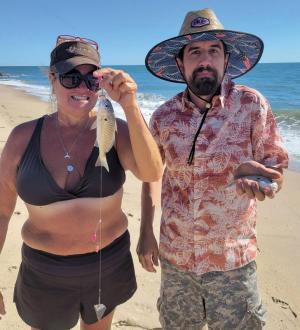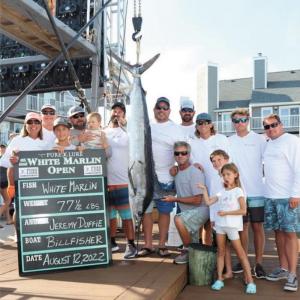Summer is winding down
The sun is setting before 8 p.m. and we are not okay with that, and yet we long for epic fall fishing. Then again, we always long for that and rarely see it. I won’t even speculate anymore how our fall season will produce. Everything changes constantly.
One thing that never changes is weekday fishing, which has been more productive than weekend for the surf. This past weekend the fishing was better despite it being a crowded weekend. The spot bite has been on point. This cooler weather is helping keep more anglers out, increasing catches.
The cooler weekend weather had a fleet of boats offshore for flounder. I heard it was more than 100 boats out in one area, and that is some pressure on the fish and the angler. This is why we mostly fish weekdays and work the weekends; I get more done and enjoy better fishing. The new Fishbites Fight Club soft plastics are producing nice catches offshore. I’m seeing these out-fish Gulp, too. I prefer larger baits and rigs offshore; those fish are looking for a big meal, not a little mummichog minnow, which are not found offshore. There are rigs guys use up north (Jersey) that look like the long lake trout rigs in Colorado. These have huge hooks and lots of blades for flash and noise, the only difference being the large whole squid for bait used for flounder. Big bait equals big fish.
I once saw a guy cast-netting mullet, throwing back the larger ones which were almost cob-sized. I asked why. He said the flounder wouldn’t eat those big fish. An old salt grabbed one put it on a hook and sent it out. He dropped a doormat on the jetty cap. You could see the outline of that big fish in the side of the flounder. A general rule for fish: If it fits in a fish’s mouth, they are eating it. It is one you learn with aquariums when you add fish. If it fits, it gets eaten.
By the way, mullet are showing more around the inland bays and Lewes Canal. It won’t be long before they are around the inlets and bay beaches.
Bloodworms are tough to find most weekends and they are expensive and somewhat subpar in quality. This isn’t the local bait shops’ fault; they can only get what is available. In most cases, shops aren’t making much off the bait; it’s just to get people through the door and also to keep the worms from dying off before they are sold.
Fishbites is your best alternative. Bloodworm formula red or chartreuse work very well. The nuclear chicken crab, sand flea, orange clam, and EZ shrimp chartreuse are favorites of mine too. I use all of these and catch plenty of fish. They all don’t work each day - that part you have to dial in. Other bait alternatives are shrimp and thick-cut bacon - the fatty part, not the meat. Small pieces of bacon will catch fish. There are also plenty of sand fleas and lady crabs to dig up.
The slot striped bass action has been great around the Delaware bay, from land, kayaks, and/or boats. Anglers have been doing well, especially in the evenings into night.
The Point opens soon and all of us peasant tag-holders are dying to fish out there on the weekends. It is less crowded in the offseason eventually on the weekends. I get to see and fish with my friends I missed all summer.
The winners of the White Marlin Open boated a $4.4 million fish on the last day. That is how you win a tournament, on the last day with a world record payout. It’s a nice payday for the angler and boat.
White perch and the usual river suspects are hitting around the waterways. Catfish are jumping, that paddle wheel is ... oh wait, wrong song. Anyway, the fishing inland has been decent, with lots of snakeheads being landed. Each year the catches seem bigger and more numerous. They are vicious fish. The song “Black Water” seems appropriate for those fish.
Summer is winding down to second summer. Last year we were catching the summer suspects into November. I’m not sure we will see that this year. These recent upwellings are really cooling things off.
The upwellings every summer create much cooler water conditions along the coast and into the bays, and more so this summer than in past years. Between tides, it is the most noticeable around the bays and some beaches. There are more than 10-degree temperature fluctuations in Masseys Ditch, according to the USGS survey station. It is making the fishing a little difficult, and in some cases turned a few species on more. Farther north of us, the water temperatures have hit as low as 57 degrees at the Barnegat Light USGS station in New Jersey.
The Nowcast OFS animation for the Delaware Bay shows just how much cooler in near real time animation. That cool pool of water below the hotter surface water is known as the Bight’s Cold Pool. That nowcast OFS is a really neat tool, just Google it.
Upwelling occurs when wind pushes warm surface water away from the coastline. Then cooler water from below, rich in nutrients, comes to the surface or upwells. A great natural indicator of an upwelling, aside from water temperatures dropping dramatically, is when we start seeing a lot of the Naked Sea butterflies along the beaches. The amount of food pushed towards the shoreline during an upwelling is massive, that food being phytoplankton, which in turn feeds everything else right up to the top of food chain.
Upwellings are also great at just keeping the hot bathtub water temperatures at bay. The opposite of an upwelling is downwelling. This is when hotter surface water “stacks” up against the coastline by winds. Eventually, that hotter water sinks to the bottom, or downwells. We haven’t seen that this year, thankfully.

























































